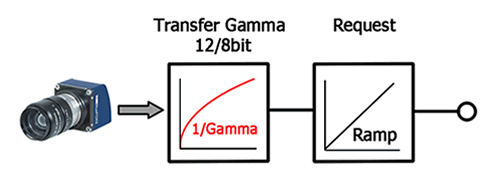Defines valid LUT(LookUp Table) modes.
More...
|
| static final int | LUTmDirect = acquireJNI.LUTmDirect_get() |
| | Maps an image by applying intensity transformation.
|
| |
| static final int | LUTmGamma = acquireJNI.LUTmGamma_get() |
| | Maps an image by applying intensity transformation with gamma correction.
|
| |
| static final int | LUTmInterpolated = acquireJNI.LUTmInterpolated_get() |
| | Maps an image by applying interpolated intensity transformation between a set of given sampling points.
|
| |
Defines valid LUT(LookUp Table) modes.
◆ LUTmDirect
| final int LUTmDirect = acquireJNI.LUTmDirect_get() |
|
static |
Maps an image by applying intensity transformation.
◆ LUTmGamma
| final int LUTmGamma = acquireJNI.LUTmGamma_get() |
|
static |
Maps an image by applying intensity transformation with gamma correction.
Since the human eye perceives light similar to a logarithm of real light intensity it's characteristic curve is non-linear. It follows the rule of (intensity ^ gamma) with a gamma value between 0.3-0.5. To provide as much useful information as possible, the image is converted from 12-bit acquired by the sensor to 8-bit utilizing this characteristic curve. The result is a linearized image optimized for the human eye's non-linear behavior which allows to perceive as much intensity differences as possible.
Conversion from 12- to 8-bit utilizing the gamma function
◆ LUTmInterpolated
| final int LUTmInterpolated = acquireJNI.LUTmInterpolated_get() |
|
static |
Maps an image by applying interpolated intensity transformation between a set of given sampling points.

